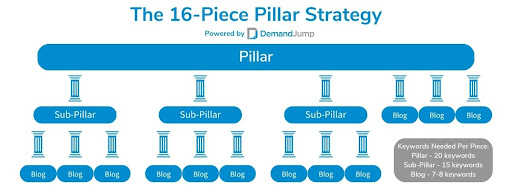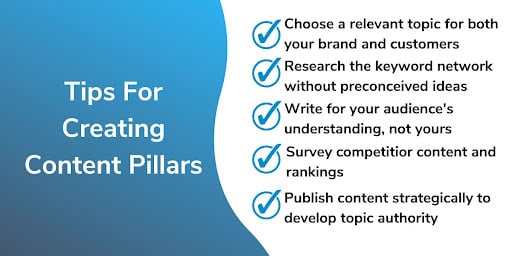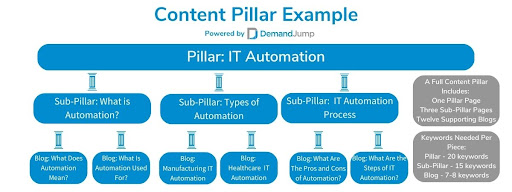Content Pillar Examples
June 14, 2021 •Josh Daugherty

Content marketers are always looking for novel new ways to connect with potential customers and bring in new business. They know how important it is to be on page one in the search rankings if they want to direct traffic to their website. They also know how important it is to create timely and relevant content—once potential customers find your content, it will answer their questions and position you as a credible authority.
No matter what industry you’re in—and how familiar or unfamiliar you are with the art of search engine optimization (or SEO)—the content pillar strategy offers a reliable framework for creating quality content that ranks.
What exactly is an SEO Pillar and how do you create a content pillar strategy that works? In this blog, we’ll help you understand how to create content pillars and look at a few content pillar examples.
What Is a Content Pillar, and What Is the Main Purpose of Pillar Content?
In the context of SEO, the phrase “content pillar” refers to both a strategy and an individual piece of content.
The content pillar itself is a blog of at least 3,000 words, which incorporates 15-20 different high-value keywords, keyword phrases, and questions. A content pillar is intended to offer readers a comprehensive, credible overview of a topic they’re searching for information about.
When coupled with content pillar strategy (more on that in the next section), pillar content is intended to achieve two main outcomes. First, pillar content provides high-quality, informative content catered to what your audience is looking for. Essentially, pillar content makes your business a trusted expert on the topic. Second, pillar content (with the right strategy in place) lets Google and other search engines know that you’re an authority, which can improve your search engine rankings—and drive more potential customers to your site.
Content Pillar Strategy
A content pillar strategy is a network of keywords and content, consisting of anywhere from 10 to 20 individual pieces of content that all interlink. In a content pillar strategy, there are three main types of content: pillars, sub-pillars, and supporting blogs.

As you’ll remember, your pillar is a high-level, 3,000 word overview of your topic. Beneath your pillar, you should include three to four support pillars that consist of 1,500 to 2,000 words each. Your sub-pillars should include a link to your pillar. Each sub-pillar should be held up by three to four supporting blogs of roughly 750 words. Your supporting blogs should link up to their sub-pillar and the pillar.
Each individual content piece addresses a specific question related to the larger pillar topic, and includes hyperlinks to drive readers to the pillar page. The strategy begins with keyword research, and ends with a collection of valuable content that will resonate with search engines and readers.
How Important Is a Content Pillar in Content Marketing?
It used to be a lot easier to create content that would rank highly within search results, as it just came down to including the right keywords in your piece. This led to a lot of uninspired content that was just stuffed with jargon and keywords. While it would effectively bring readers to a company’s website, they would quickly realize that the content wasn’t really saying anything. It didn’t seem human.
The content pillar strategy is a proven tactic for creating high-quality content that will perform well with search engines and offer timely and relevant information, while also resonating with human readers. Since this is not a method to game or cheat the system, search engine algorithm updates are unlikely to break it, meaning this approach isn’t going to quickly become outdated or ineffective.
Search engines want content that is valuable, well organized, and has a user-friendly experience for the reader. By organizing content in the pillar approach, you’ll create content that answers the distinct questions readers are asking, in the exact language they’re using. This way, your content can fit readers’ search behavior exceptionally well, resulting in leads for your business (and happy readers!).

How To Create Content Pillars
The key concept to creating content pillars comes from knowing your niche market, who your target audience is, and what exactly it is they're searching for. An easy way to answer the question “How do I find content pillars?” is to narrow down the key, short-tail term that represents what your company is selling. This key term will be the title of your main pillar and all the sub-pillars and supporting blogs will stem from it. The number of sub-pillars and blogs will depend on how wide-ranging your key term topic is. That’s why it’s important for the main pillar to focus on a broad enough topic that this kind of drilling-down is possible.
To create an effective content pillar, you’ll need to develop a solid focus and strategy. There are many different ways to do keyword research, but leveraging a tool like DemandJump can remove much of the guesswork—replacing it with a data-backed strategy to get you on page one even quicker.
How Do You Come Up With Content Marketing Pillars?
First things first: to develop content marketing pillars, you must begin by thinking of topics that apply to your business. At DemandJump, we’re obsessed with content, so it makes sense for us to have a pillar on SEO pillars (the pillar this sub-pillar is connected to). But there are other options too, like content marketing, keyword research, marketing attribution, and more. How do you choose where to start? (And don’t forget, you can always have more than one content pillar!)
For any business, the foundation of a content pillar strategy is keyword research. By illuminating the search terms and questions your target customers are looking for in the exact terms they’re using, keyword research helps you understand where to aim with your content. With the right set of keywords and topics, you can ensure your content will rank with search engines and resonate with readers.
In an episode of DemandJump's podcast, Page One or Bust!, our content writers discuss their process for deciding which content pillars to write about. To learn more, listen to this clip below or check out the full episode at this link.
Once you come up with the cluster of topics you’ll want to write about, you can start organizing your efforts and creating the content, piece by piece.
In the example of our SEO Pillar and its strategy, here are some of the high-value questions we identified as meaningful blog topics:
- How many content pillars should you have?
- How long should a pillar page be?
- What should a pillar page look like?
- How do you write a pillar page?
- What should a pillar page contain?
- What is a good pillar?
- What are some examples of pillars?
- What is the difference between a pillar page and landing page?
- What should my content pillars be?
- What is a pillar page strategy?
Additional topics included:
- Pillar page best practices
- Benefits of pillar pages
- Pillar page examples
- Content pillar template
- Pillar page design
Do some of these inevitably overlap? Absolutely. Is that a problem? Nope. Think about the last time you Googled something. You typed in your question, clicked on a result you thought would answer your question, and then what? Did you sit down and go through the company’s entire blog archives, reading each piece? Probably not. The point of the overlap is that people search for things in different ways, and you want to capture as many ways as you can to get readers on your blog.
Once a collection of topics has been assembled, you can organize them into a content pillar strategy. Rather than writing one 3,000-word content pillar and a dozen or more 750 word blogs, sub-pillars can help with organization and interlinking. A sub-pillar is just a longer blog, around 2,000 words—it might help to think of it as a mini pillar.
Going back to our “SEO Pillar” example, you’re actually reading a sub-pillar right now. Here’s what the related topic cluster looks like:
- Pillar topic: “SEO Pillar”
- Sub-pillar: “Content Pillar Examples” (this blog)
- Supporting blogs:
- “What Should My Content Pillars Be?”
- “What Is Pillar Page Content?”
- “What Are the Types of Content Pillars?”
- “How Do You Write Pillar Content”
By organizing content under sub-pillars, you increase your opportunities for inter-linking among content pieces—which helps to further demonstrate to search engines that your content is a credible authority on the topic. Here are the basics of linking:
- Supporting blogs contain links to the relevant sub-pillar and pillar.
- Sub-pillars contain a link to the relevant pillar.
- The pillar page does not link to other pieces.

Other Considerations for Content Pillar Marketing
Content pillar marketing is a process. Before you do anything else, it can be helpful to audit your existing content. For example, you may have a blog or text-heavy pages on your website. If so, check your website analytics to find out how these pages are performing. How many visitors are you getting? Where are they coming from? What is the average time on page?
Your audit can provide a wealth of information. You may already have a number of blog posts or other content that can be repurposed as part of a brand new pillar strategy. You can always refresh your keyword research and make revisions to the content, if you think it needs it.
It’s also worth checking out what your competitors are writing about. You can do this either by going to their websites and skimming their blogs and other content, or you can do some basic Google searches and take note of the first few organic search results. Take note of what your competition is writing about and exactly what keywords they’re ranking for. You will likely want to add these topics and keywords to your pillar plan to better compete.
Looking for a better day to do it? DemandJump automates much of the keyword research and content pillar strategy processes, allowing you to:
- Identify high-value keywords and questions to write about, to deliver the content your target customers are searching for.
- Understand what the competition is writing about, and how their content currently ranks.
- Develop an organized strategy to write and publish strong content that will rank well and drive traffic to your website.
- Create on-demand content briefs that collect and organize keywords, telling you exactly what you should be writing about.
One final consideration: we’ve talked a lot about high-value content, but what exactly does that mean for content pillar marketing? It’s more than selling your own brand, service, or product. You have to provide informative, educational content that your readers are looking for. Pillar content is designed for readers who are lower in the marketing funnel. Include some snippets about your own company, of course, but focus heavily on educational content.
Additional Content Pillar Examples
Content pillar strategy ideas can come from examining what your company sells and produces, or who your target audience is. The basic strategy can extend to topics relevant to any product, service, or industry—no matter how broad or niche, popular or obscure, etc. When applying the content pillar strategy, there are two important considerations you should start by asking:
Who are our target customers, and what are they looking for?
What are the main objectives as a company—driving traffic, or to drive a specific type of traffic (like scheduling a sales call or demonstration)?
With these two considerations addressed, the same basic process of keyword research and topic planning can apply. That’s one of the biggest advantages of the content pillar strategy: the basic premise and process is versatile enough to fit virtually any industry or objective.
Example #1
Let’s look at a hypothetical Florida travel company, Dream Travels, that specializes in creating custom trips to Disney World. Their goal is to increase their website traffic and, in turn, gain more leads as a result of readers wanting their services. After narrowing down their services and audience, they identified their short-tail term as “Disney World Vacation”.
Their main pillar would be titled “Disney World Vacation” and would be a 3,000-word article encompassing the broad topic and everything a person planning a vacation to Disney World would need to know.
Dream Travels would then break down the topic of “Disney World Vacation” into several supporting topics. This can all be done within DemandJump’s keyword research tools. You can even see where your content currently ranks vs. that of your competitors.
As they start to narrow their focus, some pillar pages examples for the term “Disney World Vacation” could have titles like:
- “Disney World Vacation Packages 2022”
- “Disney World Vacation Planner”
- “Planning a trip to Disney World on a Budget”
- “Disney World Resorts”
- “Best things to do in Disney World”
Supporting blogs for the “Disney World Resorts” sub-pillar could be:
- “What Is the Best Disney World Resort for the Money?”
- “Which Disney World Resort Is the Cheapest?”
- “How Do I Pick the Right Disney Resort?”
After their plan was created and the main pillar, sub-pillars, and blog topics were identified, they would set out to write the SEO content for each article.
Example #2
For a second example, let’s turn to Clear Tech Solutions, a hypothetical company that sells software analytics tools to help companies integrate their IT automation software. Their main pillar could center around the short-tail keyword, IT Automation, a broad term that covers everything the consumer needs to know about IT automation. The company would then get more specific with their sub-pillars, possibly diving into the types of automation for the target audiences they are selling to.
Some topics for sub-pillars around IT automation could include:
- What is Automation?
- Types of Automation
- Automation Process
After Clear Tech identifies their sub-pillars, they should get even more specific with their blogs.
Under their sub-pillar “What is Automation,” relevant blogs could include:
- “What Does Automation Mean?”
- “What Happens In an Automation Reaction?”
- “What Is Automation Used For?”
Under their sub-pillar “Types of Automation”, relevant blogs could include:
- Healthcare Automation
- Manufacturing Automation
- Logistics Automation
Under their sub-pillar “IT Automation Process”, relevant blogs could include:
- “How Secure Is Automation?”
- “What Are the Pros and Cons of Automation?”
- “What Are the Different Stages of the Automation Process?”

The end result of this process is an interlinking web of content that tells search engines that there is deep and rich content surrounding a topic. Another key component to this type of pillar content strategy is the velocity of publication. Publishing one blog post every week is different from publishing sixteen pieces of content at the same time. For the content pillar strategy, publishing a large quantity of articles all at once is the better option for catching search engines’ attention.
For a real-world example of a content pillar success story, check out this article on how DemandJump and Metonymy Media (which is now DemandJump’s own internal content team!) won the term “Content Marketing” on Google in less than five months.
How to Use Content Pillars for Social Media
Social Media content is the fastest-growing segment of content creation. With businesses creating so much content for social media - it is important to align your social content strategy to your overall content strategy. Enter content pillars.
Your social media content strategy should go hand in hand with your content pillars. If you have 5 content pillars (or clusters) on your website you should have 5 social media content pillars. The questions you are answering and the topics you are writing about on your website are the same questions you should be answering and topics you should be covering on social media.
Social media is all about getting in front of your prospective customers where they spend their time. The best way to get in front of them is by answering the questions they are already asking - those same questions you are answering in your content pillars. Bridge your website content pillars with your social media content in order to have a cohesive content strategy.
Build Your Content Pillar With DemandJump
Building effective content pillars that outrank competition and drive traffic to your brand’s website can be challenging. But once you know precisely what your target audience is searching for and you create a content pillar strategy based on those key words and questions, the rewards are numerous.
But how can you know for certain what your audience is searching for? Enter DemandJump. With our powerful consumer insights tools, we can help you with strategy and execution. All you have to do is come to use with your topic in hand and we’ll run you a report to find the most clear and valuable search terms for your topic. You can create an outline and start writing within minutes.
Visit our website to see our services, or try DemandJump for free today.

Featured Articles
Categories
- Attribution Tracking (13)
- Channel Optimization (11)
- Consumer Insights (68)
- Content Marketing (251)
- Data Science (8)
- Digital Marketing (6)
- Digital Transformation (26)
- Enterprise (10)
- Lead Generation (14)
- Market Intelligence (8)
- Marketing Analytics (39)
- Marketing Attribution (57)
- Marketing Management (153)
- Marketing Operations (86)
- Organic Search (222)
- Paid Search (52)
- Pillar-Based Marketing (63)
- Programmatic Advertising (9)
- SaaS Content (14)
- SaaS Marketing (29)
- Search Marketing (111)
- SEO Keyword Research (28)
- SEO Pillar (18)
- SEO Strategy (46)
- SMB (5)
- Website Content (12)


